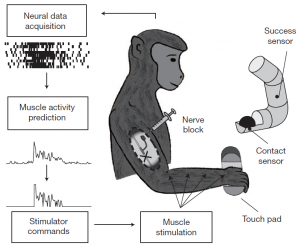Neuroprosthetics: Paralyzed No More
One in fifty people in the United States is suffering from some form of paralysis. According to the New York Times, they have gotten this way predominantly from a spinal cord injury or a stroke. Doctors have been hard at work trying to let these people live a normal life once again. A new wearable exoskeleton has given paraplegics with strength in their arms the ability to walk once again. While a huge step, it does nothing for those who have lost communication between their arms and their brain. A huge step towards reestablishing that connection took place this week. A field called neuroprosthetics could be the promising wave of the future.
Doctors at Northwestern’s Feinberg School of Medicine were able to stimulate the brains of monkeys suffering from paralysis in their hand, enabling them to move a previously paralyzed limb. Doctors built an artificial connection by implanting electrodes on the monkey’s brain that could read the activity of 100 of their brain cells, and interpret their intentions. They used these electrodes to send an electrical signal to the paralyzed muscles, causing them to react in the manner intended by the monkey. Monkeys previously unable to use their hands were then able to perform tasks such as picking up a ball and placing it inside a specified area. The recently published report noted that the “achievement is a major advance towards similar restoration of hand function in human patients.”
While lead neuroscientist Dr. Lee Miller said “There really are not major technical hurdles to trying this in humans on an experimental basis,” don’t expect to see it happen immediately. Miller noted that securing final approval and recruiting patients for human trials will probably take a few years. Fellow Neuroscientist from the University of Pennsylvania, Andrew Schwartz, also pointed out that “In a truly paralyzed (human) arm, many more muscles would have to be activated (than the 100 activated in the monkeys).” In rebuttal, Miller said that could be achieved by stimulating the nerves themselves, rather than the muscles. “In principle we should be able to activate all the muscles that those nerves innervate.”
The human brain can do some remarkable things, but if that internal link is broken, we’ve been left in limbo. Perhaps we can combine this technology with that of feeling-restoring skin to give amputees a new lease on life. Neuroprosthetics is truly fascinating, and encompasses much more than what was shown in this particular study. We truly can do anything that we set our minds to.
Comments
Tags: neuroprosthesis, neuroprosthetics, neuroscience, paralyzed no more
Trackback from your site.



Comments (1)
Maven
| #
I would have liked to see the look on the monkey’s face when he was able to use his hands, did he appear happy? surprised? curious? Anyway, this is amazing and wonderful.
Reply